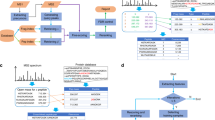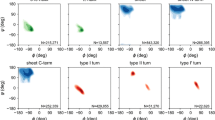Abstract
The HMCM [CG]CBCA experiment (Tugarinov and Kay in J Am Chem Soc 125:13868–13878, 2003) correlates methyl carbon and proton shifts to Cγ, Cβ, and Cα resonances for the purpose of resonance assignments. The relative sensitivity of the HMCM[CG]CBCA sequence experiment is compared to a divide-and-conquer approach to assess whether it is best to collect all of the methyl correlations at once, or to perform separate experiments for each correlation. A straightforward analysis shows that the divide-and-conquer approach is intrinsically more sensitive, and should always be used to obtain methyl-Cγ, Cβ, and Cα correlations. The improvement in signal-to-noise associated with separate experiments is illustrated by the detection of methyl-aliphatic correlations in a 65 kDa protein-DNA complex.

Similar content being viewed by others
References
Ayala I, Sounier R, Use N, Gans P, Boisbouvier J (2009) An efficient protocol for the complete incorporation of methyl-protonated alanine in perdeuterated protein. J Biomol NMR 43:111–119
Baldwin AJ, Religa TL, Hansen DF, Bouvignies G, Kay LE (2010) 13CHD2 methyl group probes of millisecond time scale exchange in proteins by 1H relaxation dispersion: an application to proteasome gating residue dynamics. J Am Chem Soc 132(32):10992–10995. doi:10.1021/ja104578n
Biswas S, Guharoy M, Chakrabarti P (2009) Dissection, residue conservation, and structural classification of protein-DNA interfaces. Proteins 74:643–654
Briercheck DM, Wood TC, Allison TJ, Richardson JP, Rule GS (1998) The NMR structure of the RNA binding domain of E. coli rho factor suggests possible RNA-protein interactions. Nat Struct Biol 5:393–399
Chan PH, Weissbach S, Okon M, Withers SG, McIntosh LP (2012) Nuclear magnetic resonance spectral assignments of α-1,4-galactosyltransferase LgtC from neisseria meningitidis: substrate binding and multiple conformational states. Biochemistry 51:8278–8292
Fernandez C, Wider G (2003) TROSY in NMR studies of the structure and function of large biological macromolecules. Curr Opin Struct Biol 13:570–580
Gardner KH, Zhang X, Gehring K, Kay LE (1998) Solution NMR Studies of a 42 KDa Escherichia Coli Maltose Binding Protein/β-Cyclodextrin Complex: chemical Shift Assignments and Analysis. J Am Chem Soc 120(45):11738–11748. doi:10.1021/ja982019w
Göbl C, Tjandra N (2012) Application of solution NMR spectroscopy to study protein dynamics. Entropy 14(3):581–598. doi:10.3390/e14030581
Goto NK, Kay LE (2000) New developments in isotope labeling strategies for protein solution NMR spectroscopy. Curr Opin Struct Biol 10:585–592
Goto NK, Gardner KH, Mueller GA, Willis RC, Kay LE (1999) A robust and cost-effective method for the production of Val, Leu, Ile (delta 1) methyl-protonated 15N-, 13C-, 2H-labeled proteins. J Biomol NMR 13:369–374
John M, Schmitz C, Park AY, Dixon NE, Huber T, Otting G (2007) Sequence-specific and stereospecific assignment of methyl groups using paramagnetic lanthanides. J Am Chem Soc 7:13749–13757
Kleckner IR, Foster MP (2011) An introduction to NMR-based approaches for measuring protein dynamics. Biochim Biophys Acta. doi:10.1016/j.bbapap.2010.10.012
Krejcirikova A, Tugarinov V (2012) 3D-TROSY-based backbone and ILV-methyl resonance assignments of a 319-residue homodimer from a single protein sample. J Biomol NMR 54:135–143. doi:10.1007/s10858-012-9667-9
LeMaster DM, Richards FM (1988) NMR sequential assignment of Escherichia coli thioredoxin utilizing random fractional deuteriation. Biochemistry 27:142–150
Markwick PR, Malliavin T, Nilges M (2008) Structural biology by NMR: structure, dynamics, and interactions. PLoS Comput Biol 4(9):e1000168. doi:10.1371/journal.pcbi.1000168
McCallum SA, Hitchens TK, Rule GS (1999) Solution structure of the carboxyl terminus of a human class mu glutathione s-transferase: NMR assignment strategies in large proteins. J Mol Biol 285:2119–2132
Mittermaier A, Kay LE (2006) New tools provide new insights in NMR studies of protein dynamics. Science 312:224–228
Mueller GA, Choy WY, Yang D, Forman-Kay JD, Venters RA, Kay LE (2000) Global folds of proteins with low densities of noes using residual dipolar couplings: application to the 370-residue maltodextrin-binding protein. J Mol Biol 300:197–212
Ruschak AM, Kay LE (2010) Methyl groups as probes of supra-molecular structure, dynamics and function. J Biomol NMR 46:75–87. doi:10.1007/s10858-009-9376-1
Salzmann M, Pervushin K, Wider G, Senn H, Wüthrich K (1998) TROSY in triple-resonance experiments: new perspectives for sequential NMR assignment of large proteins. Proc Natl Acad Sci U S A. 95(23):13585–13590
Salzmann M, Pervushin K, Wider G, Senn H, Wüthrich K (2000) NMR Assignment and Secondary Structure Determination of an Octameric 110 kDa Protein Using TROSY in Triple Resonance Experiments. J Am Chem Soc 122:7543–7548. doi:10.1021/ja0003268
Sattler M, Fesik SW (1996) Use of deuterium labeling in NMR: overcoming a sizeable problem. Structure 4:1245–1249
Shajani Z, Varani G (2007) NMR studies of dynamics in RNA and DNA by 13C relaxation. Biopolymers 86:348–359. doi:10.1002/bip.20650
Sinha K, Jen-Jacobson L, Rule GS (2011) Specific labeling of threonine methyl groups for NMR studies of protein-nucleic acid complexes. Biochemistry 50:10189–10191. doi:10.1021/bi201496d
Sprangers R, Kay LE (2007) Quantitative dynamics and binding studies of the 20S proteasome by NMR. Nature 445:618–622. doi:10.1038/nature05512
Studier FW (2005) Protein production by auto-induction in high density shaking cultures. Protein Expr Purif 41:207–234
Tugarinov V, Kay LE (2003) Ile, Leu, and Val Methyl Assignments of the 723-Residue Malate Synthase G Using a New Labeling Strategy and Novel NMR Methods. J Am Chem Soc 125:13868–13878. doi:10.1021/ja030345s
Tugarinov V, Kay LE (2005) Quantitative 13C and 2H NMR relaxation studies of the 723-residue enzyme malate synthase G reveal a dynamic binding interface. Biochemistry 44:15970–15977. doi:10.1021/bi0519809
Tzakos AG, Grace CRR, Lukavsky PJ, Riek R (2006) NMR Techniques for Very Large Proteins and RNAs in Solution. Annu Rev Biophys Biomol Struct 35:319–342
Velyvis A, Ruschak AM, Kay LE (2012) An economical method for production of (2)H, (13)CH3-threonine for solution NMR studies of large protein complexes: application to the 670 kDa proteasome. PLoS ONE 7(9):e43725. doi:10.1371/journal.pone.0043725
Venditti V, Fawzi NL, Clore GM (2011) Automated sequence- and stereo-specific assignment of methyl-labeled proteins by paramagnetic relaxation and methyl–methyl nuclear Overhauser enhancement spectroscopy. J Biomol NMR 51:319–328
Wang X, Vu A, Lee K, Dahlquist FW (2012) CheA–Receptor Interaction Sites in Bacterial Chemotaxis. J Mol Biol 422:282–290. doi:10.1016/j.jmb.2012.05.023
Xu Y, Matthews S (2013) MAP-XSII: an improved program for the automatic assignment of methyl resonances in large proteins. J Biomol NMR 55:179–187. doi:10.1007/s10858-012-9700-z
Zhuravleva A, Clerico EM, Gierasch LM (2012) An interdomain energetic tug-of-war creates the allosterically active state in Hsp70 molecular chaperones. Cell 151:1296–1307
Acknowledgments
We thank Virgil Simplaceanu for maintenance of the NMR spectrometers and Dr. C. Sanders (Vanderbilt University) for providing the Bruker code for the HMCM[CG]CBCA experiment. This work was supported by the Mellon College of Science at CMU and an NIH Merit grant 5R37-GM029207 to L.J–J.
Author information
Authors and Affiliations
Corresponding author
Electronic supplementary material
Below is the link to the electronic supplementary material.
Rights and permissions
About this article
Cite this article
Sinha, K., Jen-Jacobson, L. & Rule, G.S. Divide and conquer is always best: sensitivity of methyl correlation experiments. J Biomol NMR 56, 331–335 (2013). https://doi.org/10.1007/s10858-013-9751-9
Received:
Accepted:
Published:
Issue Date:
DOI: https://doi.org/10.1007/s10858-013-9751-9




